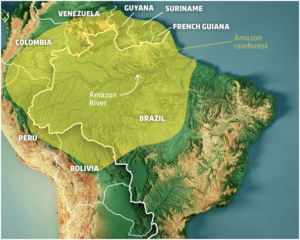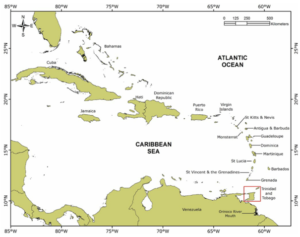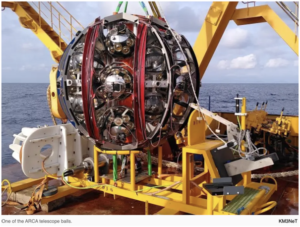IASbaba's Daily Current Affairs Analysis
Archives
(PRELIMS & MAINS Focus)
Syllabus:
- Prelims & Mains – ENVIRONMENT
Context: 2024 was a brutal year for the Amazon rainforest, with rampant wildfires and extreme drought ravaging large parts of a biome that’s a critical counterweight to climate change.
Background: –
- The Amazon is twice the size of India and sprawls across eight countries and one territory, storing vast amounts of carbon dioxide that would otherwise warm the planet.

About Amazon Rainforest
- The Amazon Rainforest, often referred to as the “lungs of the Earth,” is the world’s largest tropical rainforest.
- Lies within the Amazon River Basin, covering countries such as Brazil, Peru, Colombia, Venezuela, Ecuador, Bolivia, Guyana, Suriname, and French Guiana.
- Climate: Features an equatorial climate with high humidity, temperatures ranging from 25–30°C, and significant rainfall throughout the year.
Environmental Significance
- Carbon Sink: Absorbs 2 billion tons of CO₂ annually, mitigating global warming.
- Oxygen Production: Contributes significantly to the global oxygen cycle, earning its nickname as the “lungs of the Earth.”
- Water Cycle Regulation: Produces 20% of the world’s freshwater runoff into the oceans via the Amazon River.
- Influences global and regional precipitation patterns, including the South American monsoon.
Source: The Hindu
Syllabus:
- Mains – GS 2
Context: After Modi was sworn in for a third time in June, the year was jam-packed with incoming and outgoing visits. 2024 was full of global insecurity and shocks in the neighbourhood, particularly Bangladesh.
Background: –
- As 2025 looks to be even more uncertain, Indian foreign policy’s biggest challenge is to remain poised for change.
Key highlights of India’s external relations in 2024
- The most difficult negotiation completed was for disengagement at the Line of Actual Control with China. While restoring ties shattered by the Chinese transgressions since 2020 is a prolonged task, the first formal Modi-Xi Jinping meeting in five years at Kazan, on the sidelines of the BRICS summit in Russia, was a turning point.
- Early in 2024, the conclusion of the India-European Free Trade Association agreement, India’s first with Europe, was heralded as a template for India to complete other such negotiations, although the year ended without similar progress on FTAs with Australia, the U.K., and the European Union.
- The transformation of Bangladesh, from a friendly neighbour under Sheikh Hasina, to becoming estranged over her ouster from power was the year’s biggest shock. The MEA repeatedly raised concerns over the sharp rise in attacks on Hindu minorities that followed, and Ms. Hasina’s stay in India has become the biggest thorn in the relationship.
- Ties with Canada took a turn for worse as Canada doubled down on allegations that Indian officials had ordered the Nijjar killing, even naming Home Minister Amit Shah in the alleged conspiracy.
- U.S. Department of Justice filed indictments against the Adani group and a new indictment against an Indian official for the alleged Pannun assassination plot comes as new challenges in relationship with US.
- The U.S.’s role in the South Asian neighbourhood, especially with the changes in Bangladesh, and China’s forays into Nepal and other neighbours are a continuing challenge. However, the election of U.S. President Donald Trump and the largely pro-India team he has picked could be a breather.
How did Indian foreign policy navigate global conflict?
- With both the Russia-Ukraine conflict and Israel’s war in Gaza, India consistently put itself on the “side of peace”.
- While New Delhi repeatedly called for an end to the civilian casualties, it continued to hedge its position at the UN on resolutions seeking to bring Israel to account for the killings in Gaza.
- With multilateral initiatives like IMEC (India-Middle East Europe-Economic Corridor) and I2U2 (India, Israel, UAE and U.S.) in trouble, India sought to engage West Asian countries bilaterally.
Source: The Hindu
Syllabus:
- Prelims – GEOGRAPHY
Context: The government of Trinidad and Tobago declared a state of emergency on Monday (December 30), following a deadly weekend of violence in the Caribbean dual-island nation.
Background:
- Trinidad and Tobago has a population of 1.5 million and already accounted for one of the highest murder rates in the Caribbean, along with Jamaica and Haiti.

Key takeaways
- Trinidad and Tobago is a twin-island nation located in the southern Caribbean, near the northeastern coast of Venezuela. It is the southernmost island country in the Caribbean.
- It is an active member of CARICOM, Organization of American States (OAS), and the Commonwealth of Nations.
- Trinidad is the larger and more populous island. Tobago, the smaller island is located northeast of Trinidad.
- The capital city is Port of Spain, located on the island of Trinidad.
History
- Colonial Past: Trinidad was colonized by the Spanish in the 16th century, followed by the British in the 19th century. Tobago changed hands between the British and French several times before becoming a British colony.
- Indentured Labour: After the abolition of slavery, Indians were brought as indentured laborers (1845–1917) to work on sugar plantations, shaping the country’s demographics and culture.
- Independence: Trinidad and Tobago gained independence from Britain on August 31, 1962.
- Republic: The country became a republic within the Commonwealth on August 1, 1976.
Culture
- Carnival: Trinidad and Tobago is famous for its Carnival, a world-renowned festival featuring colorful parades, music, and dance.
- Music: The islands are known for their contributions to calypso and soca music.
Source: Indian Express
Syllabus:
- Prelims & Mains – SCIENCE & TECHNOLOGY
Context: Scientists are deploying two telescopes to detect high-energy neutrinos, also known as ghost particles, under the Mediterranean Sea. The two telescopes are part of the Cubic Kilometre Neutrino Telescope or KM3NeT.
Background: –
- These telescopes are much like the IceCube Neutrino Observatory, which can detect high-energy neutrinos from deep space but is under the frozen ice in the Antarctic rather than being in the water.
What are neutrinos?
- Detected for the first time in 1959 — though their existence was predicted almost three decades earlier, in 1931 — neutrinos are tiny particles, very similar to electrons, but without any electric charge.
- They are one of the fundamental particles the universe is built of, and are the second most abundant subatomic particles after photons.
- Neutrinos are so numerous that about a billion of them pass through a cubic centimetre of space every second.

Why do scientists want to study high-energy neutrinos?
- Although neutrinos are everywhere, not each one of them is important to study. Scientists are interested in examining super-fast, high-energy neutrinos that have come from far, far away. Such neutrinos are rare and mostly originate from exotic events such as supernovae, gamma-ray bursts or colliding stars.
- Studying high-energy neutrinos can help astrophysicists investigate those space mechanisms and regions like the centre of our Milky Way Galaxy which are shrouded in dust. Dust absorbs and scatters the visible light from objects, making them difficult or impossible to observe with optical telescopes.
why are scientists building underwater neutrino telescopes?
- High-energy neutrinos, however, are not just rare but also extremely difficult to detect. One reason is that neutrinos barely interact with anything.
- To detect high-energy neutrinos, there is a need for a large volume of optically transparent material in a place where it is extremely dark. The location needs to be dark because the detectors look for flashes of Cherenkov radiation: light that neutrinos produce when they interact with a water or ice molecule.
- These flashes help scientists trace the path of that neutrino, giving them details about its source, the amount of energy it contains, and its origins.
Neutrino Observation efforts
- Cubic Kilometre Neutrino Telescope (KM3NeT)
- The Cubic Kilometre Neutrino Telescope (KM3NeT) is a cutting-edge European research infrastructure designed to detect neutrinos.
- Location: KM3NeT is located at the bottom of the Mediterranean Sea. It consists of two main detectors: ARCA (Astroparticle Research with Cosmics in the Abyss) and ORCA (Oscillation Research with Cosmics in the Abyss).
- IceCube Neutrino Observatory
- The IceCube Neutrino Observatory is a pioneering astrophysical observatory located at the South Pole.
- Location:
- Situated within the Antarctic ice sheet near the Amundsen-Scott South Pole Station.
- Utilizes over 1 cubic kilometer of ice as a detection medium.
- IceCube, which has been operational since 2011, was the first telescope to detect high-energy neutrinos.
Source: Indian Express
Syllabus:
- Prelims – SCIENCE & TECHNOLOGY
Context: A surge in the outbreak of Norovirus has been detected in parts of the United States.
Background: –
- In India, norovirus has previously affected people in Kerala, although on a much smaller scale compared to the numbers in the US.
Key takeaways
- Norovirus is a highly contagious virus that is also sometimes referred to as the ‘winter vomiting bug’.
- Also referred to as the stomach flu or the stomach bug, norovirus causes inflammation in the intestines or stomach, also known as acute gastroenteritis.
- It is similar to diarrhoea-inducing rotavirus and infects people across age groups.
- It can be transmitted through contaminated food, water, and surfaces. The primary route is oral-faecal.
Symptoms of norovirus?
- The initial symptoms of norovirus are vomiting and/or diarrhoea, which show up one or two days after exposure to the virus.
- Patients also feel nauseous and suffer from abdominal pain, fever, headaches and body aches. In extreme cases, loss of fluids could lead to dehydration.
What precautions can one take against norovirus?
- One may get infected multiple times as the virus has different strains.
- Norovirus is resistant to many disinfectants – such as hand sanitisers – and can withstand heat up to 60°C. Therefore, merely steaming food or chlorinating water does not kill the virus.
- The basic precaution is to repeatedly wash hands with soap after using the lavatory or changing diapers. It is important to wash hands carefully before eating or preparing food. During outbreaks, surfaces must be disinfected with a solution of hypochlorite at 5,000 parts per million.
What is the treatment for norovirus?
- The disease is self-limiting. The infection usually lasts only two or three days, and most individuals who are not very young, very old, or malnourished can ride it out with sufficient rest and hydration.
Source: Hindustan Times
Practice MCQs
Q1.) Which of the following is true regarding Trinidad and Tobago?
- It is a twin-island nation located in the Pacific Ocean.
- Trinidad is the smaller island, while Tobago is the larger one.
- It is the southernmost island country in the Caribbean.
- The country is not a member of the Commonwealth of Nations.
Select the correct answer using the code given below:
(a) 1 and 2 only
(b) 3 only
(c) 1 and 4 only
(d) 2, 3, and 4 only
Q2.) Why is underwater neutrino telescopes considered ideal for detecting neutrinos?
(a) The high salinity of seawater enhances neutrino interactions.
(b) The darkness and large volume of optically transparent water allow the detection of Cherenkov radiation.
(c) Proximity to tectonic activity aids in better neutrino detection.
(d) The presence of abundant marine life helps in studying neutrino behavior.
Q3.) Consider the following statements regarding Norovirus:
- It is also known as the “winter vomiting bug.”
- Norovirus can be effectively killed by hand sanitizers.
- The primary route of transmission is oral-faecal.
Which of the statements given above is/are correct?
(a) 1 and 2 only
(b) 2 and 3 only
(c) 1 and 3 only
(d) 1, 2, and 3
Comment the answers to the above questions in the comment section below!!
ANSWERS FOR ’ Today’s – Daily Practice MCQs’ will be updated along with tomorrow’s Daily Current Affairs
ANSWERS FOR 31st December – Daily Practice MCQs
Q.1) – a
Q.2) – b
Q.3) – b













